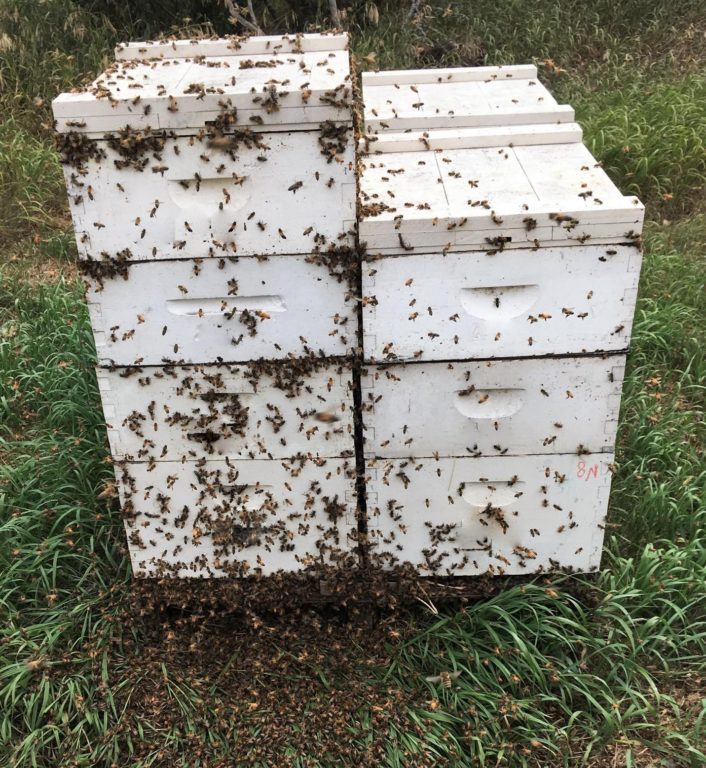Robber bees are foraging honey bees gone bad! Robbing bees take the fast track to riches – they invade another colony to steal insufficiently protected stored honey reserves or sugar water being fed to a colony other than their own. Robber bees aren’t trying to destroy another colony, rather they seek to save their own colony from starvation. Honey bees are compulsive hoarders. Rare in natural nests, robbing is all too common in our modern apiaries when we site colonies of varying strength in close proximity.
Robbing behavior is not subtle. Robber bees can be identified by their concerted attempts at gaining access to the hive where there might be an entrance. Clues to robbing include:
- Increased levels of activity, almost frantic in nature, at the front of a hive
- Robbers seek alternative means to gain hive access such as under the colony top, beneath the bottom screen and at “seams” between the boxes.
- Fighting bees may tumble and roll in the air on the hive entrance and on the ground in front of the entrance.
- Dead bees, some shiny from loss of body hairs, on the ground in front of the hive.
Robbers search for weakened colonies to enter and steal honey. If the robber bees get inside the hive, they will rip open capped honey cells. As robber bees leave the hive, laden down with honey, they often need to crawl up the side of the box to gain some elevation. You may observe them dip towards the ground once launched as they take off.
Once the robber bees have invaded the interior, the colony is weakened even further and the chances of this hive surviving without beekeeper intervention decrease dramatically. While a strong hive might be able to defend itself against robbers, colonies that are weaker can be overwhelmed by robbers from neighboring colonies. Compounding the damage, the robbers may pick up varroa mites as they rob. This occurs especially if the weakness of the colony being robbed is due to high mite numbers.
Robbing can happen any time, but it’s most commonly seen in late summer to early fall, especially during a nectar dearth. Colonies without a queen or those replacing their queen are also vulnerable to probing foragers looking to rob. Another condition that has been described as potentially leading to robbing is dwindling of colonies due to increasingly elevated populations of Varroa mites. Guarding is over rated as a deterrent – guard bees normally intercept only around 5% of bees entering their colony. Even under poorer foraging conditions, guards challenge no more than 2/3rds of bees entering their hive.
Preventative measures are the key to protecting your colony against robbing.
- Rule 1 is Don’t let robbing start
- Rule 2 is to Stop it immediately if you suspect robbing
- Rule 3 is See Rule 1 and 2.
Conditions that might start robbing include:
- Opening a hive
- Scraping burr comb and dropping it on the ground
- Strong and weak colonies in same apiary
- Multiple hive entry/exits
- Sudden or prolonged nectar dearth
- Hive lacking robbing screens and/or entrance reducers.
If you suspect robbing act fast. Err on the side of caution. You might suddenly see a weaker colony such as an earlier split or colony that replaced their queen recently, ‘come to live’ with entrance activity. You might see bees fighting at entrance or on ground in front of a colony, some appearing shiny without body hairs. Maybe you see bees investigating seams and cracks, seeking to get into a hive at non-existent “openings”. If you don’t intervene, the robbed colony is likely to lose most of its adults and/or lack enough stores to survive the winter.
Immediately reduce the main opening and tape/close all other entrances. Lean a piece of wood or plastic at 45-60◦ angle over the entry area. If bees are gathered on colony, cover the entire hive with an old sheet or bedspread that you have thoroughly wetted for rest of day, rewetting if it dries out. If you have one, replace covers with screen top covers. Shut down flight in/out as fast as you can. An alternative to covering the hive is to position a heavy water sprinkler directed at the entrance/front of the hive. If an option, relocate a weak colony before it is killed.
For more tips see Robber bees – how to deal with them: https://carolinahoneybees.com/honey-bee-robbing-behavior/
David Peck, now at Betterbee, examined robbing as a factor in transmission of varroa mites with Tom Seeley while at Cornell. Their study of inter-colony mite transmission positioned six black-colored bee hives, nearly mite-free, around a cluster of three heavily mite-laden colonies of yellow-colored bees. The experiment was able to demonstrate the colonies with the dark colored bees picked up high mite numbers as the yellow-bee colonies collapsed. They suggested “robber lures” was a better descriptive term than “mite bombs” for colonies succumbing to high mite loads before winter.
Peck, David & Tom Seeley. 2019. Mite bombs or robber lures? The roles of drifting and robbing in Varroa destructor transmission from collapsing honey bee colonies to their neighbors. https://journals.plos.org/plosone/article?id=10.1371/journal.pone.0218392
Tips to Prevent Robbing in Your Apiary
- Don’t be messy in the bee yard. Don’t spill sugar water when refilling feeders. Any pieces of wax or burr comb should be collected and taken away from the hive area
- Use entrance reducers and keep the opening small (especially) for weak colonies
- If your colonies are starving due to a dearth, feed them
- Equalize colony strength by moving frames of (mostly capped) bee brood between colonies. Be careful not to move the queens! Spray the moved frames with a light mist of sugar water to reduce fighting
- Hive inspections can create robbing situations. During times of dearth, keep your inspections brief.

